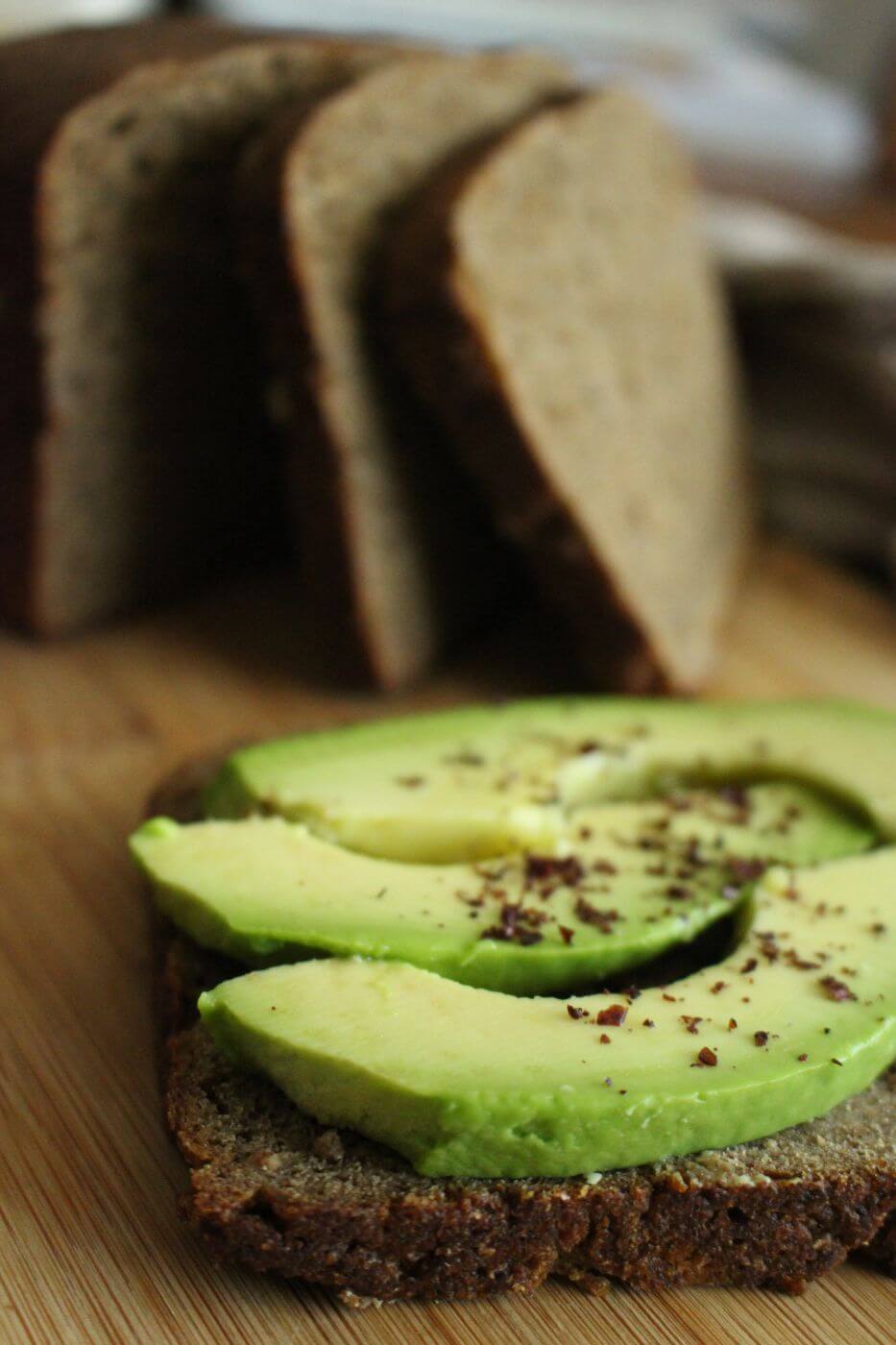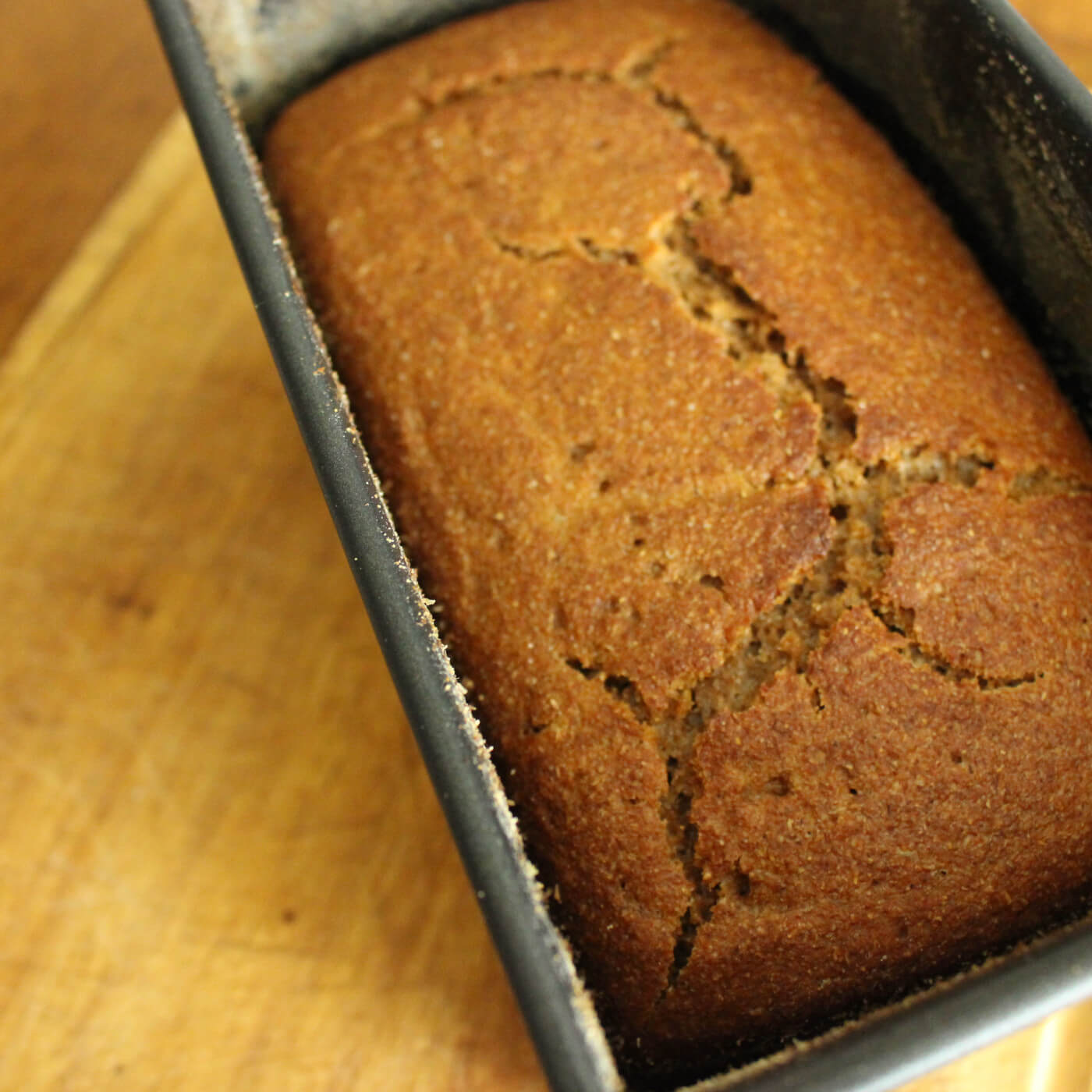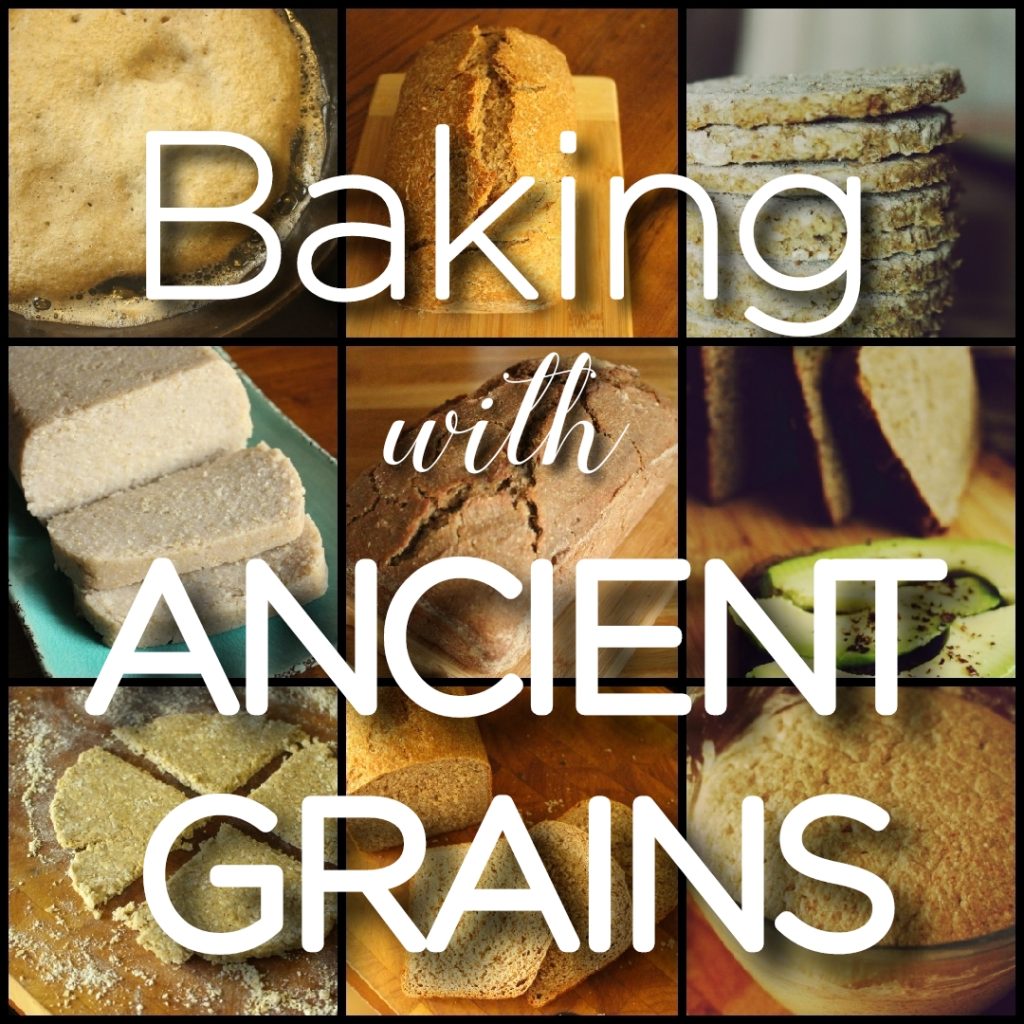Making rye sourdough bread from the whole grain will reward you with an amazingly-tasty loaf – rich, deep, sweet and tangy. And, contrary to popular belief, it’s not hard to make. In fact, in many ways, sourdough rye is easier to produce than sourdough wheat bread. With my recipe you’ll see that there’s no kneading or shaping required, and yet you’ll still get a loaf that is easily-sliceable – one that you can become an everyday staple in your kitchen.

Why choose 100% rye bread (rather than a wheat hybrid)?
I’ve been baking 100% wholegrain rye sourdough breads for a decade. My husband has a wheat allergy – I started this journey for him, but have since uncovered a world of wholegrain rye bread-making that has brought so much flavour and ease to my home-baking. It can do this to your kitchen too – rye breads are in many ways easier to manage than wheat and taste amazing! The foundation of my wholegrain rye baking is the recipe I share with you here, an everyday wholegrain rye sourdough that I make in my kitchen every week.
How baking with rye is different…
The process of making bread with rye is very different to making bread with grains like wheat (including spelt). Wheat-style grains use what’s called the ‘gluten mesh network’ to trap air and help breads rise. Rye doesn’t, instead when mixed with water it forms a gel which holds fermenting gases and creates a crumb.
In some ways baking bread with rye is easier – there’s no kneading, no shaping and no prodding of the dough to guess whether it is ready to bake. Instead, to optimise the rising process we use a pre-ferment, mix a thick batter and watch each step carefully.
What you’ll need:
- An active sourdough starter (which doesn’t have to be rye).
- A loaf pan with a total cubic volume of at least 2000ml and a cover (which can be made of aluminium foil).
- A probe or laser thermometer is helpful.
Timings:
You’ll start the process the evening before you want to bake the bread. Then, on bake day, you’ll mix the dough early, pan it mid-morning and have a baked loaf come early afternoon.
100% Wholegrain Rye Sourdough Bread Recipe

This bread is from my video course Rye Sourdough Bread: Mastering the Basics. All its steps (and much more including sourdough starters plus three more 100% wholegrain sourdough rye recipes) are part of my course.
Evening before you bake – create the preferment:
Ingredients:
- 260g water (non-chlorinated)
- 65g mature rye sourdough starter (if you need help with this, check my pay-what-you-can course here)
- 260g wholegrain rye flour
Method:
- In a clean bowl, preferably glass, mix together 260g water and 65g of mature sourdough starter until the starter has broken up well.
- Add 260g rye flour and stir until all the flour is mixed in.
- Cover and leave somewhere warm (22C/72F is ideal) to ferment overnight.
Bake day:
In the morning, check that your preferment is active. It should be light and airy with a network of bubbles.

There may be tiny holes on its surface and it should smell really fizzy/fruity (there are photos and video in my course to compare yours to). If it’s ready, proceed to mixing the final dough:
Ingredients:
- 358g wholegrain rye flour
- 10g salt
- c. 228g water (if your ambient/water temperature is less than 22C/72F it can be useful to warm up this water to 35C/95F)
- 30g honey
- All of the above preferment
Method:
- In a bowl, mix together the flour and salt.
- In a separate bowl, preferably glass, mix the honey into the water.
- Add the preferment to the water/honey and stir until it is mixed in.
- Add the rye flour/salt to this liquid and mix. Make sure all the flour has been brought into the dough and that everything is evenly distributed.
- If you are using glass it is, at this stage, useful to squash down the dough, pushing it against the the bowl. Once done, you should familiarise yourself with how the dough looks against the sides of the bowl. This action will help you to later gauge when the bulk fermentation stage is complete.
- Cover the dough and leave somewhere warm (22C/72F is ideal) to ferment.
- Watch the dough. At 22C/72F, my dough takes around 2 hours. At that point it has usually created a curve on its surface, smells fermented and lots of little holes have appeared on the inside of the glass bowl.
This recipe is included in The Beginner’s Guide to Wholegrain Rye Sourdough, designed to give you everything you need to turn out loaf after loaf of beautiful, delicious sourdough from this ancient grain. Get your copy, free, here:
When you are happy that your dough has completed the bulk fermentation stage, you are ready to pan the dough:
- Grease and flour a suitable loaf tin.
- Spoon the mix into the loaf tin, pushing it down so that it reaches the bottom and corners of the tin.
- Using a wetted spatula, smooth the top of the loaf and, if desired, curve the top of the loaf to create a pleasing shape.
- Leave the loaf somewhere warm (22C/72F is ideal) to proof. The loaf should be covered (to avoid the top drying out). You can do this by placing the whole tin inside a plastic box, by covering the loaf using damp dish towels placed over a fly screen, by wetting/oiling the top of the loaf and covering the tin with clingfilm or by tenting the loaf tin with aluminium foil.
- Watch the loaf. At the temperature above my dough takes around 1-1.5 hours to be ready to bake.
- As you are watching the loaf, be prepared to preheat your oven. This bread goes into a hot oven. If you leave it until the bread is ready to preheat your oven, you will end up with an over-proofed loaf. My oven takes almost 25 minutes to get to 220C/430F which means I usually turn it on about 45 minutes into the proofing process.
- Back to watching the loaf! Check how the loaf is doing by looking at its surface – tiny little holes will appear and increase in number as the loaf gets towards the end of its fermentation. You can choose to bake your loaf early, when you just start to see holes (and the loaf will rise in the oven) or later, when the whole loaf has more of these little holes (and the loaf will probably not rise much in the oven). I generally choose somewhere in the middle. This way my loaf rises a little in the oven.
- When the loaf is ready, ensure it is covered with the tin lid or with an aluminium tent.
- Put the loaf into your preheated to 220C/430F oven for 15 minutes.
- After these 15 minutes turn the oven down to 190C/375F for a further 45 minutes.
- After these 45 minutes, take the loaf from the oven and remove the lid. Return it to the oven and cook for a further 15 minutes, watching to make sure it does not burn. The loaf will be ready when it sounds hollow when knocked on the bottom and has an internal temperature of over 98C/208F.
- Remove the loaf from the tin and place it on a cooling rack. Leave it for at least 24 hours before slicing.
FAQs
Why do you say I should wait 24 hours before slicing this bread?
Because the crumb of rye bread is created by a gel structure, the loaf continues to ‘cook’, gaining structural integrity, as it is cooling. It is very important that you do not cut wholegrain rye bread whilst it is still warm and, if you can stop yourself, the structure and flavour really improve if you can leave the bread 24 hours before cutting.
How long does this bread last?
Traditionally, rye was the bread chosen to take on sea voyages because it lasts a long time! Wholegrain rye bread is moist and lasts a lot longer than the equivalent wheat bread. The sourdough leavening further extends this shelflife. I routinely keep wholegrain rye sourdough breads for a week without either mould or dryness ruining the bread. Loaves that are older than five days can benefit from being toasted before serving.

How should I store this wholegrain rye sourdough bread?
I leave the freshly-cooked wholegrain sourdough rye bread on a breadboard until cutting and, when first cut, turn the remaining loaf face down on the board to protect the crumb. After a day or so, I transfer this bread to my bread bin (which is metal with small air holes and a wooden lid). It lasts here for up to a week. If your environment is particularly damp and you keep this bread for a week, you may want to watch for mould, perhaps moving to a dryer area.
Can I freeze wholegrain rye sourdough bread?
Yes, this loaf freezes so well (better than any of the other ancient grains I make sourdough bread with), retaining it’s softness and flavour. Wrap the loaf (or half of your loaf) well and it’ll be happy in the freezer for months. Defrost it at room temperature.
Do I have to have a rye sourdough starter for this bread?
No, you can use any sourdough starter for this loaf.
My loaf sunk in the oven, why?
It is likely it was over-proofed. Rye gives clear signs as to when it is ready to be panned and/or put in the oven. It needs to be watched carefully with this is mind as too long at any of the stages will over-proof, causing it to sink in the oven. If you need help with this my video course Rye Sourdough Bread: Mastering the Basics will show you, with video and photos exactly when your bread is ready to be baked, helping you get perfectly risen loaves.

I’d love to mill my own rye flour, how can I do this?
Milling flour at home is a joy for me with my counter-top Mockmill. If you’re interested, take a look at my post Want to Freshly-Grind Grains for Bread?

You might also like:
An in-depth introduction to baking sourdough with rye: podcast episode Wholegrain Sourdough Rye: Mastering The Basics.
How to Make Wholegrain Rye Sourdough Bread from Scratch
Differences Between Breadmaking with Wheat and Rye
Traditional Danish Øllebrød (Rye & Ale Porridge)

Bring ancient grain baking into your kitchen!
Download my free 30-page guide with five healthy and tasty 100% ancient grains recipes.


Is this sourdough rye bread real dense? My sourdough might not have been real vibrant but the bread taste good and the loaf is heavy and dense. Thanks.
Hi Marion, Yes, the bread is dense. Authentic wholegrain rye bread is dense. It’s 100% rye we are using and it’s 100% wholegrain too. You barely find that out in the world – most rye breads are white rye mixed with wheat. You can see a clear picture of the crumb of my 100% wholegrain rye sourdough bread in this post: https://ancestralkitchen.com/2025/04/14/how-to-make-sourdough-rye-bread-from-scratch/
Having said that, as you become more confident with this process/recipe there are many things you can do to ensure you get as much rise as possible: a strong starter, the right timings for getting into the pan and the right timings for getting into the oven.